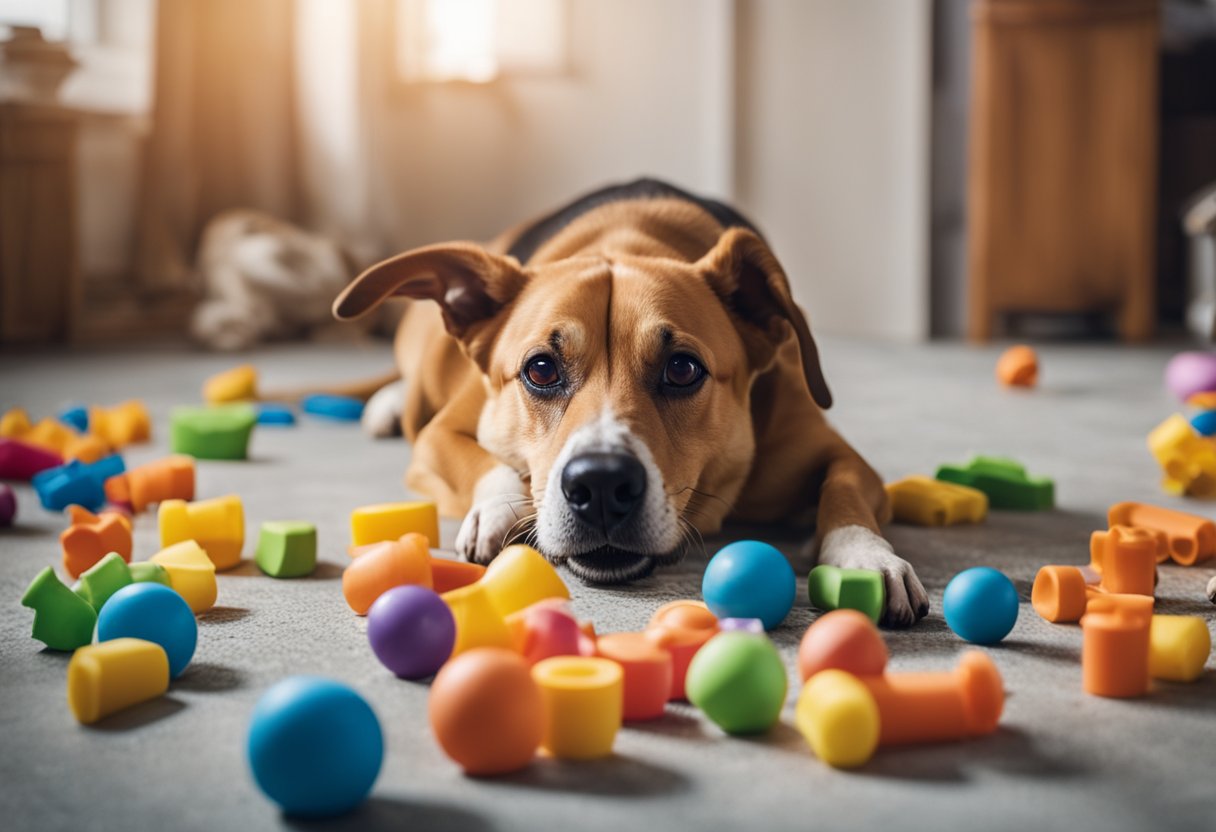Like us, our furry companions experience stress and anxiety, though their symptoms may not always be as obvious. We’ve all noticed changes in behavior when our pets are faced with a new environment or loud noises, but sometimes the indicators are subtler. It’s crucial for us as pet owners to recognize these signs, as prolonged stress can affect their health and happiness.

Smart devices for pets are revolutionizing the way we understand and manage our pet’s well-being. These gadgets can monitor their activity, track their location, and even dispense treats. With their help, we’re better equipped to detect the symptoms of anxiety and stress in our pets, create a comforting environment for them at home, and decide when it’s necessary to seek professional advice.
Key Takeaways
- Recognizing pet anxiety and stress is vital for their well-being.
- Smart devices aid in monitoring and relieving pet stress.
- Professional consultation is beneficial when managing pet anxiety.
Understanding Pet Anxiety and Stress
We’ve all witnessed our pets acting uneasy at times, but what’s really going on inside those furry heads? Our goal is to shine a light on the triggers and signs of pet anxiety and stress, focusing particularly on how technology and smart devices can play a role in understanding and managing our pets’ emotional well-being.
Causes of Anxiety and Stress in Pets
Pets, much like us, can experience anxiety and stress due to a multitude of factors. Let’s be precise:
- Changes in Environment: A new home, the introduction of new pets, or even furniture rearrangement can disorient your pet.
- Separation: Many pets struggle with being apart from their owners. Smart devices like pet cameras allow us to monitor and interact with our pets, providing reassurance when we’re away.
- Age-Related Issues: Senior pets can develop cognitive dysfunction, making them more prone to anxiety. Innovations like GPS trackers can help us safeguard our aging companions.
- Noises and Phobias: Thunderstorms, fireworks, and other loud noises can terrify pets. Calming technologies, such as noise-cancelling pet beds, can offer some refuge.
Signs and Symptoms of Pet Anxiety
Knowing what to watch for is crucial in identifying if our pets are stressed or anxious:
- Behavioral Changes: This can range from excessive barking or meowing to unexplained aggression.
- Physical Signs: Shaking, panting, and excessive grooming are common manifestations of distress.
- Avoidance: Hiding or escaping behaviors signal that a pet is trying to avoid stressors. Interactive pet toys can help distract and reduce stress levels.
- Destructive Actions: Chewing furniture or scratching walls can also be an outlet for a stressed pet. Employing automated smart feeders can provide timely meals, helping to manage stress around feeding times.
Through close observation and leveraging smart devices designed for our pets, we can create a soothing environment and address the root causes of their anxiety and stress.
Common Triggers for Anxiety and Stress

We all want our furry friends to feel safe and happy, but sometimes they experience anxiety and stress, just like us. It’s important to understand what might trigger these feelings so we can help them cope better. Let’s explore some typical triggers to watch out for.
Separation Anxiety Triggers
Separation anxiety in pets is a common challenge, especially when they’re left alone. It’s one of the main reasons why smart devices have become so valuable in keeping our pets calm. Items such as a treat-dispensing pet camera can keep them engaged and provide comfort with our voice, even when we’re not at home.
Environmental Stressors
Changes in their environment can also cause stress to our pets. For example, loud noises from fireworks or thunderstorms are known to be significant stressors. That’s where smart devices like noise-cancelling kennels can offer a safe haven, shielding our pets from disturbing sounds.
Social Triggers
Our pets often feel stressed in social situations, whether it’s because of the presence of strangers or other animals. Smart devices like pet monitors can alert us when our pet is feeling anxious, so we can provide timely reassurances with a soothing word or calming music.
Treatment and Management

When the tail stops wagging and our furry friends begin to display signs of anxiety, it’s up to us to provide them with the comfort and care they need. We understand how disheartening it can be to see a pet in distress, so we’re committed to offering effective treatment and management strategies. Through a blend of behavioral therapies, medical interventions, and stress prevention techniques, we can help restore their happiness and well-being.
Behavioral Therapies
In response to pet anxiety, we consider behavioral therapies key to a long-term solution. These methods involve training that can help pets learn to cope with stress. For instance, desensitization helps gradually expose our pets to their fear-trigger in small doses, reducing their anxiety over time. We also employ counter-conditioning, which creates a positive association with what typically causes them stress by pairing it with a reward.
Medical Interventions
Occasionally, behavioral therapies need to be supported by medical interventions. If a pet’s anxiety is particularly intense, we may recommend consulting a veterinarian for prescription options such as Alprazolam, a medication known to help pre-empt anxiety episodes. However, we always prioritize safety and administer these medications strictly in line with professional veterinary guidance.
Stress Prevention Techniques
Finally, we’re big proponents of stress prevention techniques, utilizing smart devices for pets that can offer solace and security even when we’re not at home. Devices like automated treat dispensers can provide regular rewards, making our pets feel cared for anytime. In addition, introducing smart toys that engage their minds and alleviate boredom can prevent stress from building up in the first place.
Supporting Your Pet at Home
We all want our pets to feel as comfortable and stress-free as possible within our homes. That’s why we’re focusing on creating a serene space, ensuring sufficient physical and mental exercise, and providing the right diet to keep our furry friends both happy and healthy.
Creating a Calm Environment
Our homes should be a sanctuary for our pets, where noise and chaos are minimized. We recommend smart devices like noise-cancelling kennels that can help mute the loud sounds that often cause our pets anxiety. Also, consider setting up a specific area in your home where your pet can always find peace away from the hustle and bustle.
- Soothing Sounds: A smart sound machine with gentle nature sounds can alleviate our pet’s anxiety.
- Comforting Scents: Diffusers with pet-safe essential oils can provide a calming atmosphere.
Exercise and Mental Stimulation
Keeping our pet active is essential, but it’s not just about physical exercise; it’s also about mental stimulation. We love using interactive smart toys that can engage them in play even when we’re not home.
- Daily Routine: Establishing a consistent routine for walks and playtime.
- Smart Toys: Puzzle feeders and treat-dispensing cameras can keep our pets entertained and engaged.
Diet and Nutrition
What we feed our pets plays a crucial role in their stress levels and overall well-being. There are smart feeders that can dispense the right amount of food at the right time to maintain a balanced diet.
- Balanced Meals: Remember, a healthy diet should be rich in nutrients that can help combat stress.
- Hydration: Ensure our pets have constant access to fresh water, potentially through a smart water fountain that encourages drinking.
When to Consult a Professional

When our furry friends begin to show signs of stress or anxiety that we can’t alleviate with usual comfort measures, it’s time to consider professional assistance. We know how tough it can be to see our pets in distress, that’s why we’ve gathered the most critical moments when it becomes essential to seek a veterinarian’s expertise.
Veterinarian and Veterinary Behaviorist Roles
Veterinarians are the first professionals we turn to when our pets show signs of anxiety or stress. They can rule out any medical conditions that might be causing or contributing to our pet’s distress. For more complex cases, a veterinary behaviorist is the specialist we want on our side. They’re like pet psychologists and can offer more tailored solutions, which might include behavior modification plans that we can facilitate through smart devices designed for pets.
Recognizing Professional Help Signs
Recognizing when our pets need professional help is crucial. If our pet’s anxiety doesn’t improve with the smart devices we’ve integrated into their daily routine or if they’re showing severe symptoms, such as destructive behavior when we’re away, it may be a sign of separation anxiety. In these cases, consulting a professional is necessary. Other signs that call for professional advice include a sudden change in behavior or when the anxiety is impeding on their quality of life — and ours.
Frequently Asked Questions
We’ve gathered some critical insights to help you understand and address pet anxiety. It’s paramount we ensure our furry companions lead joyful and serene lives. Let’s look at commonly asked questions about pet anxiety and stress.
What are common indicators of anxiety in pets?
Panting, trembling, excessive barking, and destructive behavior are symptoms of anxiety in dogs. Our cats might hide or appear restless, indicating distress.
How can I alleviate my pet’s anxiety effectively?
Creating a calming environment with smart devices like pheromone diffusers can provide reassurance. Also, establishing a routine and using interactive toys can help keep them occupied and relaxed.
Are there medications available for treating stress in animals?
Yes, there are prescription medications that a vet might recommend for severe cases. These should always be used under professional guidance.
What natural remedies can help soothe an anxious pet?
Natural remedies such as massages, calming music, or anxiety wraps can be soothing. Smart pet devices can also play therapeutic sounds or release calming scents.
What behaviors signal severe stress in dogs?
Dogs might exhibit extreme behaviors like persistent whining, aggression, or attempts to escape. This might point to a deeper issue that could require professional help.
How does anxiety impact a pet’s overall health?
Chronic anxiety can lead to health issues like decreased immunity, heart problems, and disruptive digestive patterns. It’s important for us to recognize and address these signs early.

